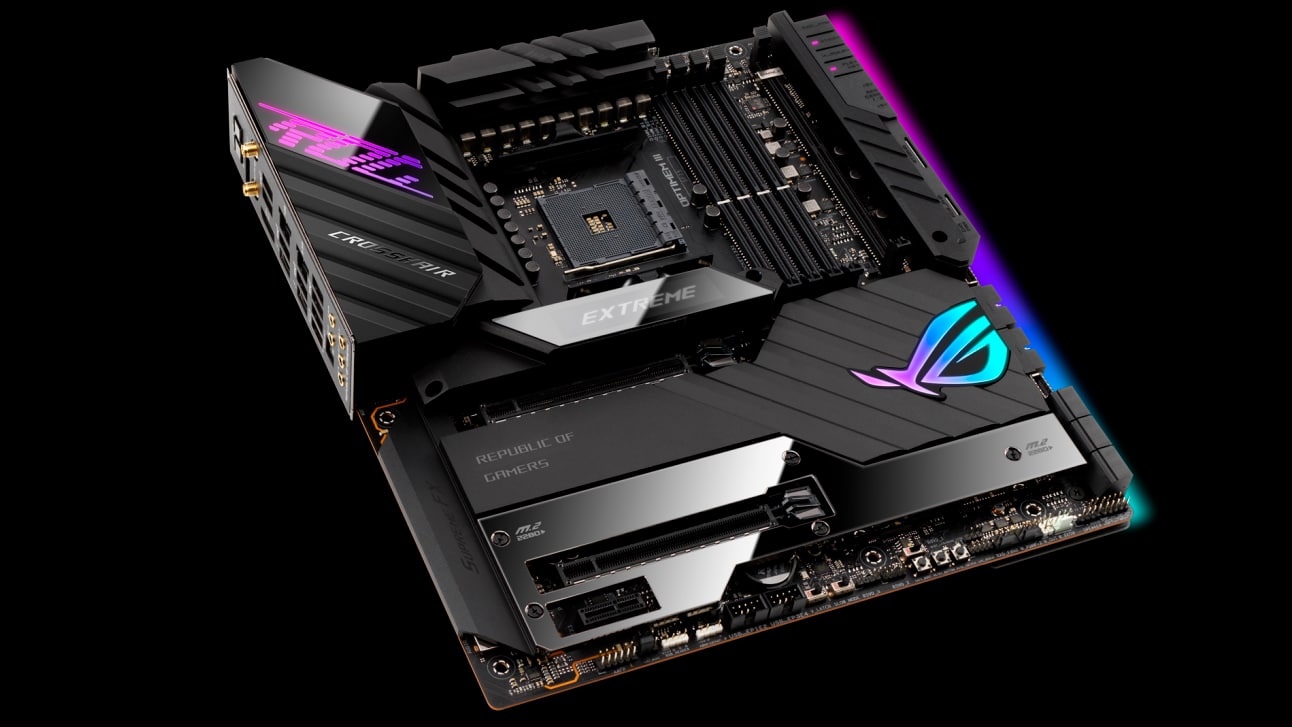Nowadays, HDTV support is becoming more and more relevant as devices capable of displaying high-quality video are increasingly found in users’ homes. In order to obtain the maximum image quality, such devices are connected to signal sources through the so-called component connection, or, as it is also called, YPbPr.
High image quality when connected according to this standard is due to the fact that the YPbPr signal supplied to the input of a TV or plasma / LCD panel does not undergo unnecessary conversions from composite to S-Video, but is immediately converted to RGB + synchronization signals and fed to a cathode ray tube or the matrix of the video display device.
In this regard, a logical question arises – why YPbPr, and not immediately RGB + HV (Horisontal / Vertical Synchronization)? The answer to this question is quite simple – the fact is that at the time of the birth of the DVD standard, it was the component video signal that was adopted as the standard for subsequent digitization and compression using the MPEG-2 algorithm.
All consumer DVD players thus output the YUV color-difference signal rather than RGB; the latter is obtained by converting from YUV either directly in the player (which introduces additional distortions), or already in the display device itself. High-quality YPbPr to RGB converters are installed in modern high-quality consumer video information display devices, whether they are televisions based on cathode ray tubes, plasma / liquid crystal panels or video projectors. therefore, it is best to feed them with a component video signal. The quality obtained at the same time is so high that it is quite suitable for viewing high-definition video in HDTV format, as well as for other purposes that require high-definition images.
Since, one of the possible sources of a video signal may be a personal computer, it is not surprising that support for component output in modern video adapters is becoming more and more relevant, and with the spread of the HDTV format, its relevance will only increase. Today we will talk about a special version of the RADEON X600 XT, created by ASUSTeK Computer. One of the main features of this product is the ability to connect to video display devices equipped with component video input.
Generally speaking, video adapters created by the Canadian company ATI Technologies have been able to output a component video signal for a long time, since the days of the RADEON 8500. The introduction of the new standard did not cause any particular difficulties – all the necessary conversions were entrusted to the driver, which appropriately reprograms the DAC of the video card, however, to connect devices with component input required a special adapter, purchased separately and not included with most cards based on graphics processors from ATI Technologies. The world famous company ASUS, creating Extreme AX600 XT / HTVD, and this is the name the new product received, took a completely different path. We will tell you about the original, albeit somewhat controversial approach of this manufacturer a little later, but for now let’s get acquainted with the “armor” of the product,
ASUS Extreme AX600 XT: packaging and contents
Like other ASUS products we’ve tested so far, the Extreme AX600 XT / HTVD arrived in the lab in retail. Unlike representatives of the X800 family, the box in which the video adapter was packed turned out to be much smaller, however, its design style remained the same – on the left, in the highlighted field, the name of the company in the corporate font, and on the right – a colorful picture:
As you can see, this picture shows the same girl who decorates the boxes in which the ASUS AX800 PRO and AX800 XT video adapters, which have already been in our laboratory, were once packed. In our opinion, this relatively small flat box made of thick cardboard is much more convenient to transport than those creatures of giant mania in which ASUS supplies the market with high-end video adapters, even though they are equipped with carrying handles. Still, walking down the street with a bright cardboard suitcase that attracts the attention of all passers-by is not very convenient. 🙂
The back side of the package is quite informative – here all the features of the product are described, and all cables and adapters included in the kit are listed, so that a potential buyer does not have to open the box in order to check the package contents.
Inside the box is neatly divided by a cardboard insert into three niches, in one of which, on the left, rests the round orange case with CDs already familiar to our readers. On the right, in a socket made of soft porous material, the video adapter itself rests, and in the lower, hidden compartment there are all the necessary cables and adapters:
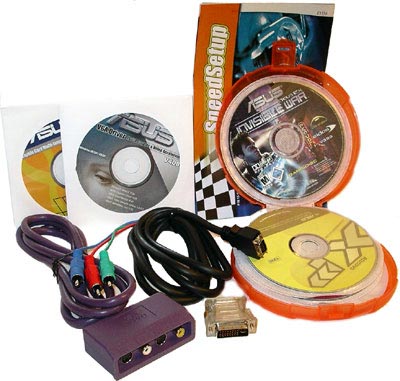
DVI-I-> D-Sub
adapter YPbPr adapter
VIVO breakout box
In addition to the above items, the box also contains a quick installation guide for the video adapter, as well as two CDs in paper bags – one with drivers and utilities from ASUS, and the other with a complete user manual in multiple languages. This approach is not devoid of reasonableness, since, as a rule, few read this manual, and to install the card into the system, a simple booklet is enough, where all the necessary operations are briefly described. The orange plastic box that comes with most ASUS video adapters and is familiar to our readers from previous reviews contains the following set of CDs:
CD with ASUS DVD player
CD with ASUS PowerDirector 3DE software
CD with CyberLink MediaShow SE 2.0
CD with Ulead Cool 3D SE 3.0 and Photo Express SE 4.0 software
2 CD with Deus Ex: Invisible War
Considering the support for VIVO functions, the ASUS EAX600 XT / HTVD software suite is excellent. However, all ASUS video adapters that visited our laboratory could boast of an excellent package bundle, so the company simply continued its good tradition. As for proprietary ASUS technologies, such as GameFace Live, VideoSecurity Online, OnScreenDisplay, SmartDoctor and SmartCooling, they are fully supported by the new product. You can learn about these technologies in the reviews dedicated to the ASUS V9950 , ASUS 9800 XT / TVD , ASUS AX800 PRO , and ASUS V9999 Gamer Edition video adapters .
The new technology, which we have never seen before, is called ASUS HyperDrive and is, in fact, an analogue of CATALYST Overdrive. Unlike the dynamic overclocking technology created by ATI Technologies, ASUS HyperDrive technology is more advanced because it has three operating modes – 3D Game Mode, CPU Usage Mode and Temperature Mode:
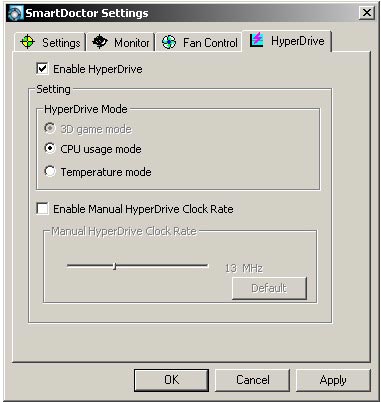
The first mode controls the GPU frequency depending on the running application. If this app uses 3D graphics, HyperDrive will automatically increase the VPU frequency. This mode requires the installation of the proprietary ASUS driver. The second mode, CPU Usage Mode, is rather unusual – when the load of the system’s central processor increases, it also increases the VPU frequency. However, in many cases, the increase in CPU utilization has nothing to do with 3D applications, and, in such cases, increasing the frequency of the GPU may be not only useless, but also negatively affect the stability of the system as a whole. The third mode can be called gentle, because when the VPU temperature rises to a certain level, it reduces its frequency.
Unlike CATALYST Overdrive, HyperDrive technology allows the user to set the overclocking level himself. By default, this figure is 13 MHz, however, it can be either increased or decreased at will. In general, ASUS HyperDrive technology is not something new or especially necessary, but its presence proves that the company always strives to be at its best in everything – and it succeeds quite well.
Taking the card in his hands
The ASUS Extreme AX600 XT / HTVD video adapter itself is rather unusual – just take the card in hand and take a closer look at it. Despite the fact that its design, at first glance, is identical to the reference, in fact, this is not entirely true.
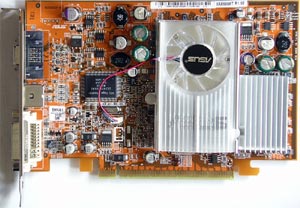
The presence of the RageTheater chip and accompanying small elements on the PCB immediately catches your eye, however, the main difference from the reference board is not this. If you take a closer look at the board, you will see that in place of the usual 15-pin D-Sub connector there is a certain non-standard gray connector. This is the connector designed to connect devices with component input – televisions, plasma panels and video projectors. This is what the included adapter cable looks like:

A controversial solution from a technological point of view, especially when you consider that a card equipped with such a connector loses one of its advantages – the ability to work with two computer monitors at the same time. Now only a monitor and any device with YPbPr input can be connected to it at the same time. In this regard, the approach of NVIDIA and S3 Graphics looks more logical – the YPbPr splitter is connected to the circular video output connector, and both monitor connectors – DVI and D-Sub remain in place. ATI Technologies’ approach is also quite reasonable – devices equipped with a component video input are connected directly to D-Sub or DVI using a special adapter. What caused the ASUS decision to replace one of the standard connectors with a connector for a YPbPr splitter, we do not know, however, one way or another, “thanks”
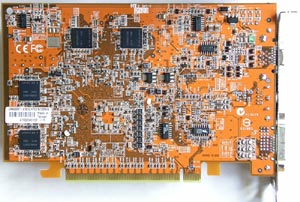
The rear side of the printed circuit board of the described product also differs slightly from the reference design. The most likely reason for such differences is the presence on board the EAX600 XT / HTVD of a proprietary hardware monitoring and cooling system control system. As for the rest, the PCB design is similar to that used by ATI Technologies when creating the RADEON X600 XT.
Let’s return, however, to the front side of the PCB and consider the cooling system for this video adapter. It is quite simple – a small aluminum radiator with curved fins covers the graphics processor and four memory chips located on the front side of the board. Thermoplastic material is used as a thermal interface between the GPU and the heatsink sole, and the memory transfers heat to the heatsink through soft white rubber-like gaskets. Quite a familiar picture for a modern video adapter. As in many other products, the memory on the back of the PCB is not cooled in any way, which reduces the overall cooling efficiency. However, almost all manufacturers are guilty of this – rarely do they install cheap, in general, heatsinks on memory chips located on the reverse side of the PCB.
The fan axis is not aligned with the VPU die; instead, it blows an air stream into the region of the crystal. This solution is common these days. It is quite justified, since when the fan is placed directly above the VPU, a dead, uncooled zone is formed, which greatly reduces the cooling efficiency. The radiator is covered with a transparent plastic shroud that guides the air flow and embellished with the company logo. For some unknown reason, this casing is removable – just pull it up slightly and it slides out of the radiator, sliding in the curly grooves in it. This is probably done for the convenience of cleaning the radiator from dust, although few people perform this operation with video adapters. The fan itself is equipped with a bright blue backlight; it seems that its presence is also becoming one of the ASUS traditions.
As for the technical characteristics, they fully justify the word Extreme, which is present in the name of the product. For example, the memory from Hynix installed on the PCB of this card has an access time not 2.5, as usual, but 2 nanoseconds, which, in theory, means that it can work at a frequency of 500 (1000) MHz. We didn’t expect to see such fast memory on a card belonging to the RADEON X600 XT family. However, such a low access time does not at all guarantee reaching a frequency of 1 GHz – this will most likely be hindered by a relatively simple PCB design. However, it will be known exactly when trying to overclock. By default, the memory runs at a slightly overestimated frequency of 370 (740) MHz, while the graphics core operates at the standard frequency of 500 MHz, as it should be.
Noise, acceleration and 2D quality
If you don’t use ASUS SmartDoctor, the cooler that comes with the EAX600 XT / HTVD card makes a lot of noise. Although this noise is not high-frequency and therefore not too annoying, its level is still very high. However, as soon as you install the above utility, the noise level immediately drops to an almost acceptable level, and if you use the SmartDoctor controls, you can make the card almost silent. In other words, this question is entirely in the hands of the user himself. The overclocking pleased me pleasantly – the memory worked steadily at 440 (880) MHz, and although the coveted 500 (1000) MHz was not achieved, this result should also be considered excellent, taking into account the PCB design that is not specially adapted to such frequencies.
The graphics processor was able to overclock up to 630 MHz, which is also an excellent result, indicating that ATI’s technical process has been worked out perfectly. As far as 2D quality is concerned, nothing special can be said about it. Despite the use of an additional adapter (the card is equipped with only a DVI connector), the picture on the screen of the Dell P1110 laboratory monitor remained clear in all resolutions, up to 1800x1440x75 Hz inclusive. Unfortunately, we were unable to test the quality of the component video output due to the lack of a video signal display device equipped with the corresponding input in our laboratory. In the future, perhaps we will make up for this omission.
In-game testing: test platform configuration and list of applications
For testing, we used our standard lab platform with the following configuration:
Intel Pentium 4 560 (Socket 775, 3.60GHz, 1MB L2 cache);
Intel Desktop Board D925XCV;
1GB DDR2 PC2-4300 (533MHz) SDRAM (Micron Technology, 2x512MB);
Samsung SpinPoint SP1213C (Serial ATA-150, 8MB buffer);
Creative SoundBlaster Audigy 2;
Microsoft Windows XP Pro SP2, DirectX 9.0с;
ATI CATALYST 4.8, NVIDIA ForceWare 61.77.
During testing, the following list of applications was used:
3D first-person shooters:
Call of Duty;
Doom III;
Unreal Tournament 2004;
Halo: Combat Evolved;
FarCry;
Painkiller;
Counter Strike: Source;
Highly Anticipated DX9 Game 1;
Highly Anticipated DX9 Game 2.
3D shooters with a third person view:
Splinter Cell: Pandora Tomorrow;
Prince of Persia: Sands of Time;
Max Payne 2: The Fall of Max Payne.
Simulators:
IL-2 Sturmovik: Aces in the Sky;
Lock On;
Colin McRae Rally 04.
Strategies:
Command & Conquer Generals: Zero Hour;
Perimeter.
Semi-synthetic tests:
Aquamark3.
Synthetic tests:
Futuremark 3DMark03 build 340.
In each specific case, the graphics quality was set to the highest possible level, the same for cards based on graphics processors from ATI and NVIDIA. For cards based on NVIDIA GPUs, anisotropic and trilinear filtering optimizations have been enabled in ForceWare settings.
Game tests: Call of Duty
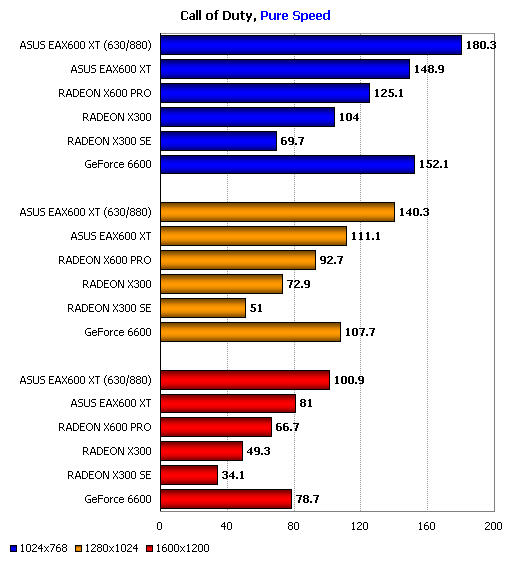
Call of Duty is one of the simplest games we use in our testing process. Pixel shaders in it are used only for displaying the water surface. Nevertheless, the game prefers cards from ATI Technologies, although in this case the hero of our review had to share the first place with the GeForce 6600, which, at its low frequencies, has eight pixel pipelines and a more perfect architecture. However, excellent overclocking for a card based on RADEON X600 allows the ASUS product to take the lead.
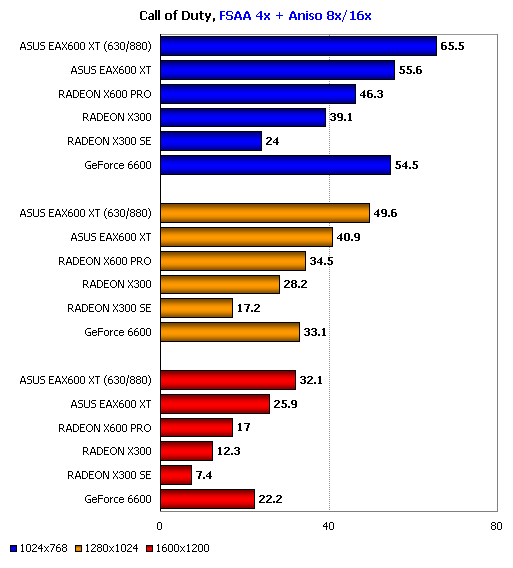
With FSAA and anisotropic filtering enabled, even the overclocked ASUS EAX600 XT leads in resolutions over 1024×768. Overclocking also has a more than noticeable effect.
Game tests: Doom III
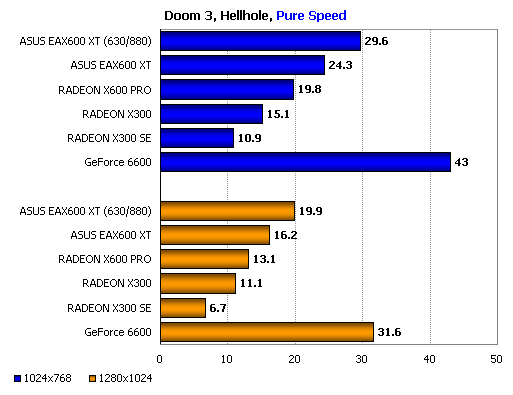
Doom III does not need a description – this name is familiar to everyone. As our readers already know, the game prefers cards with NVIDIA architecture, so the results obtained are not surprising – the first place is taken by the GeForce 6600.
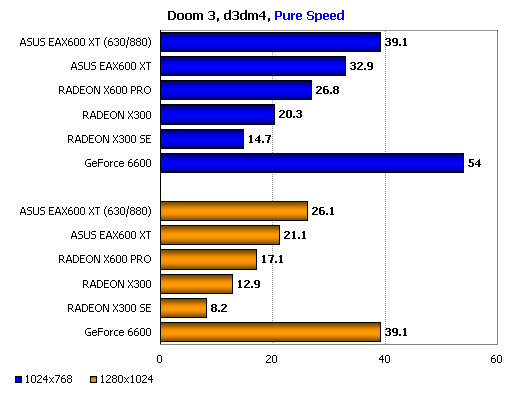
Absolutely the same situation is observed at the d3dm4 level, intended for multiplayer games, except that the FPS values are higher here due to the absence of monsters.
Game tests: Unreal Tournament 2004
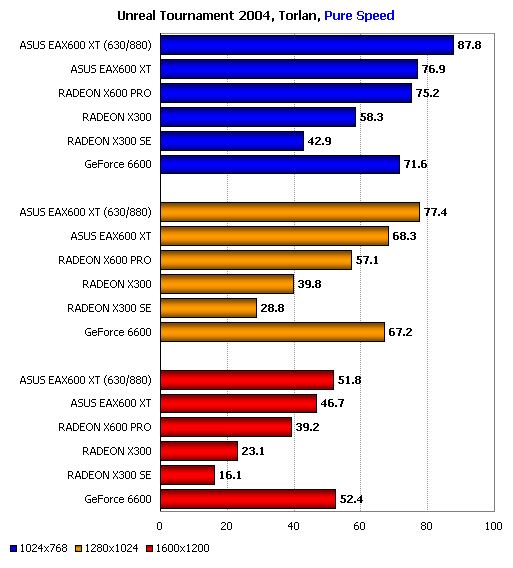
Despite the beautiful textures and rather complex geometry, Unreal Tournament 2004 can no longer be called a new generation game – there are no exceptional special effects, and pixel shaders are not used. In the lowest resolution, here we can see a slight superiority of ASUS EAX600 XT over the GeForce 6600, but as it grows, the latter manages to equalize the score and then somewhat outperform the ASUS product at 1600×1200. The overclocking effect of the Extreme AX600 XT is clearly visible in this game as well.
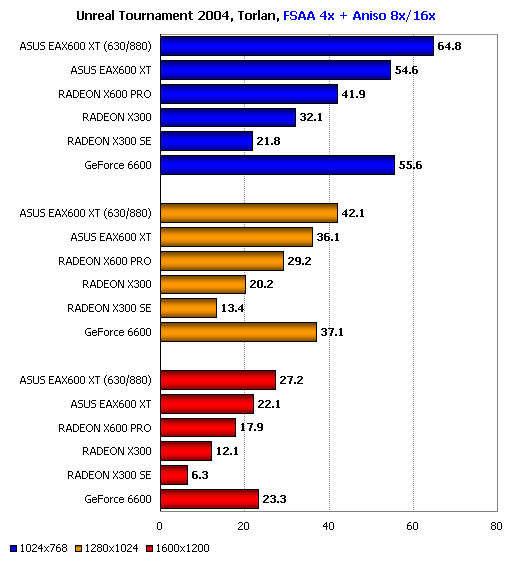
But in Eye Candy mode ASUS Extreme AX600 XT maintains parity with GeForce 6600 in all three resolutions and outperforms it only when overclocked. The greatest benefit in this case comes from memory overclocking, which practically reaches 900 MHz.
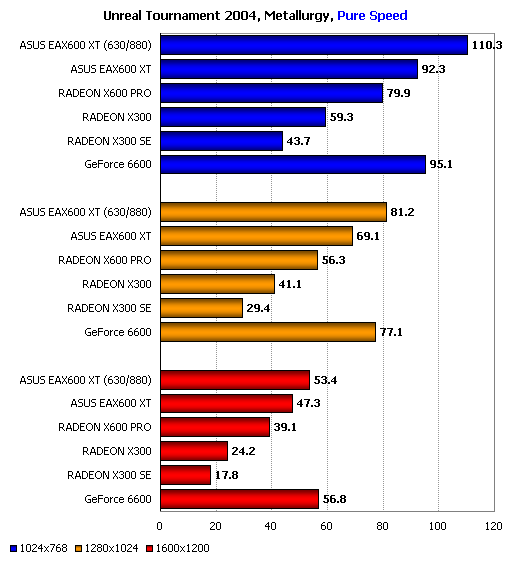
At the Metallurgy level, everything is a little different – in this case, the GeForce 6600 looks a little better than the ASUS Extreme AX600 XT, especially at high resolutions. No wonder – the brainchild of NVIDIA carries three vertex processors on board versus two of the ASUS product, while the load at this level is mainly geometrical.
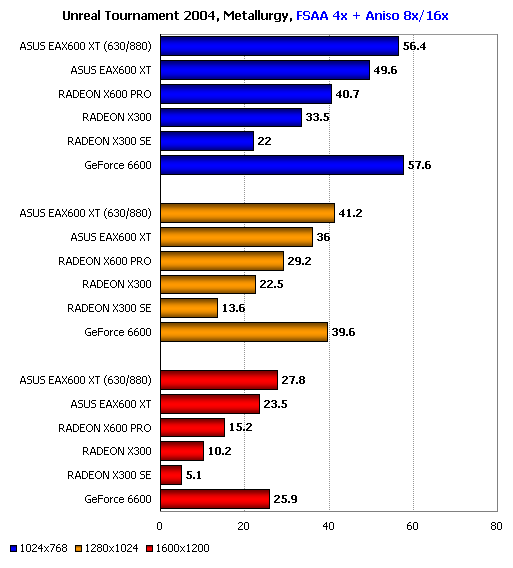
With FSAA and anisotropic filtering enabled, the advantage remains for the GeForce 6600, although more efficient methods of working with memory in ASUS Extreme AX600 XT make themselves felt – at 1600×1200 the advantage of the GeForce 6600 is no more than two frames per second. Overclocking the ASUS card allows it to easily keep the par with the GeForce 6600.
Game Tests: Halo: Combat Evolved
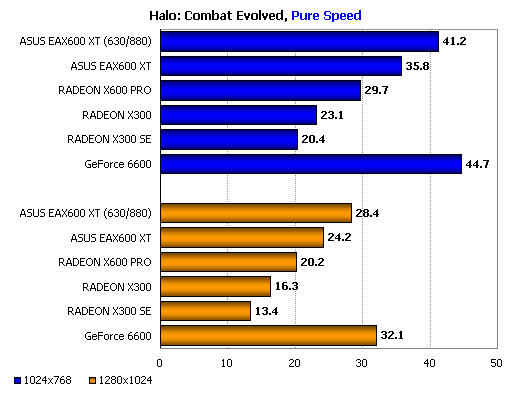
Halo is a game with relatively simple textures, but rich in pixel shaders. The victory of the GeForce 6600 in this case is not surprising – this card uses a more perfect architecture than all the other test participants, and besides, it has eight pixel pipelines, versus four in other cards. Overclocking ASUS EAX600 XT, however, can significantly reduce the gap between it and the GeForce 6600. In this case, the frequency of the graphics core is more important, since the speed of pixel shaders execution depends on it.
Game tests: Far Cry
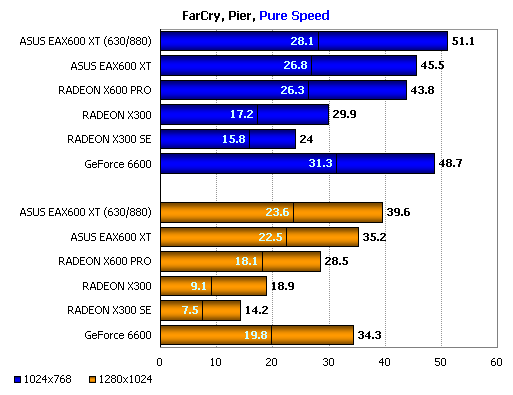
At the Pier level, the situation looks ambiguous – the GeForce 6600 has 8 pixel pipelines and a new generation architecture, but ASUS Extreme AX600 XT compensates for all this with high operating frequencies. At 1024×768, the hero of our review is slightly behind the most dangerous rival, but evens out the score at 1280×1024. Overclocking allows it to take first place in both tested resolutions. The 1600×1200 resolution was not used due to poor results.
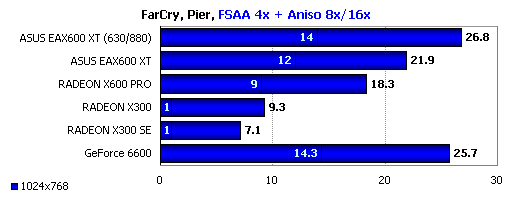
In Eye Candy Extreme mode, the AX600 XT is not saved even by high frequencies, and it is inferior to the GeForce 6600, however, overclocking allows you to correct the situation.
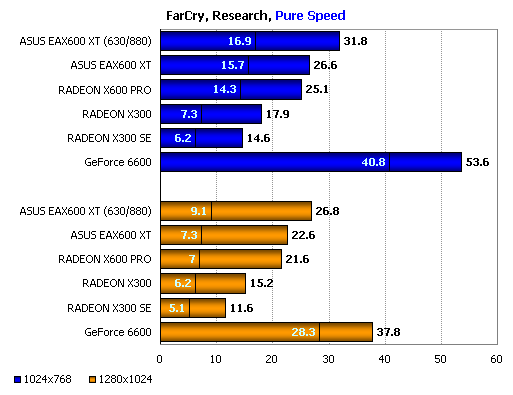
At the Research level, the victory of the GeForce 6600 looks stunning – it demonstrates more than one and a half times superiority over the overclocked ASUS Extreme AX600 XT. However, the NVIDIA card operates in Shader Model 3.0 mode, which allows it to render indoor lighting sources in one pass, while cards supporting only Shader Model 2.0 do several passes.
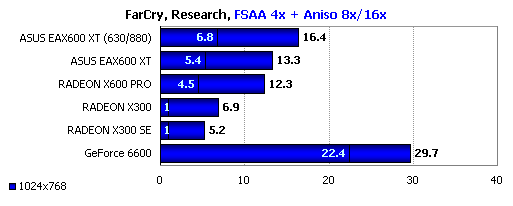
The same is observed when you enable full-screen anti-aliasing and anisotropic filtering at the same time.
Game Tests: Painkiller
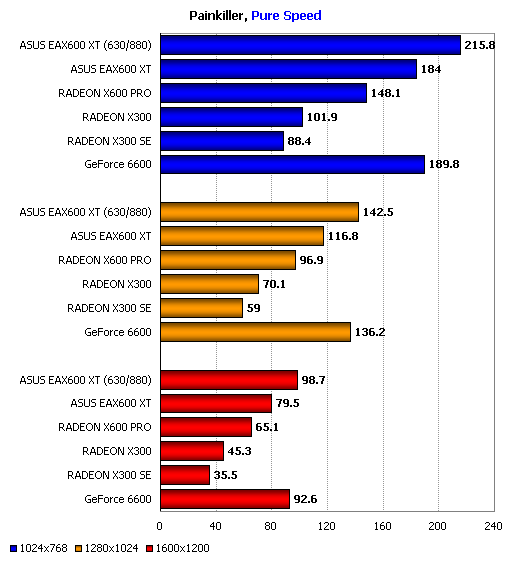
In this shooter, the superiority of GeForce 6600 over ASUS Extreme AX600 XT in high resolutions is again observed. However, overclocking the latter allows achieving equality and even superiority in the resolution of 1024×768. We remind you that this game uses a fairly complex geometry, as well as various shader special effects. The architectures of the new generation cope with both of them perfectly, while the cards based on the RADEON X600 have to rely only on high clock frequencies.
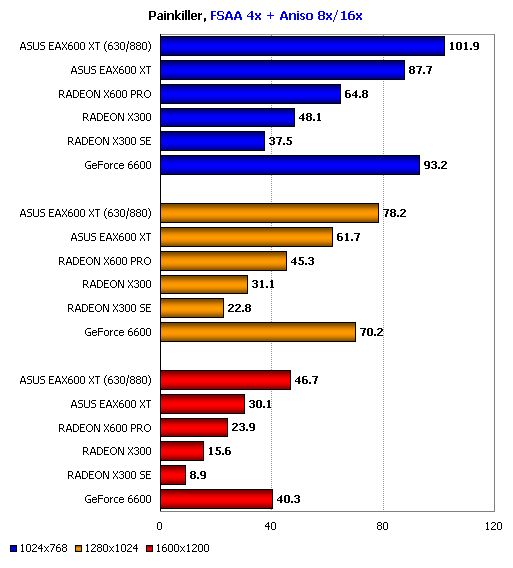
Only the maximum overclocking allows ASUS Extreme AX600 XT to successfully compete with the GeForce 6600 in the mode with FSAA and anisotropic filtering enabled.
Game tests: Highly Anticipated DX9 Game 1
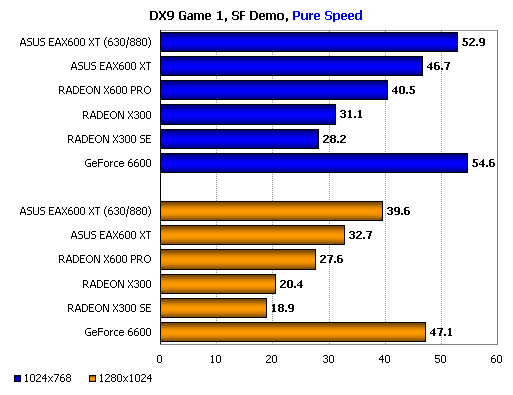
Performance in this long-awaited game is heavily dependent on the speed at which the pixel shaders are executed. The GeForce 6600 is doing excellently with this, therefore, the results obtained are not surprising. Overclocking ASUS EAX600 XT somewhat improves the position of this card, but it is still not enough to compete on equal terms with the architecture of the new generation, albeit operating at low clock frequencies by today’s standards.
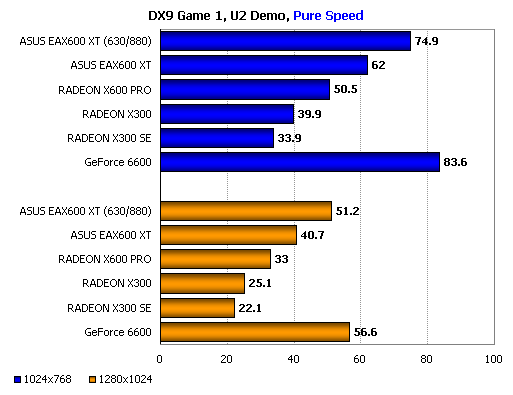
A similar picture is observed at the second level of the aforementioned game, except that the effect of the Extreme AX600 XT overclocking in this case is somewhat greater – with its help it is possible to achieve an increase in performance by about 10 FPS while the overall performance is at the level of 60-70 FPS.
Game tests: Highly Anticipated DX9 Game 2
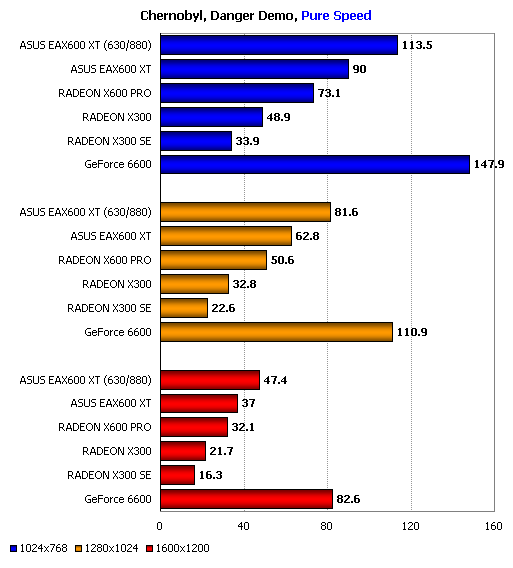
The second game of the next generation is much simpler, at least the version that is used in our reviews – it does not use the capabilities of DirectX 9, but the load on verisin processors is extremely high due to scenes with complex geometry. Once again, the GeForce 6600 demonstrates excellent results due to the presence of three vertex processors as well as architectural features that make it possible to work more efficiently with old applications that use the capabilities of fixed TnL. As for the ASUS EAX600 XT, it shows a very average result, but the performance gain from overclocking is more than noticeable and amounts to about 20 frames per second at low resolutions.
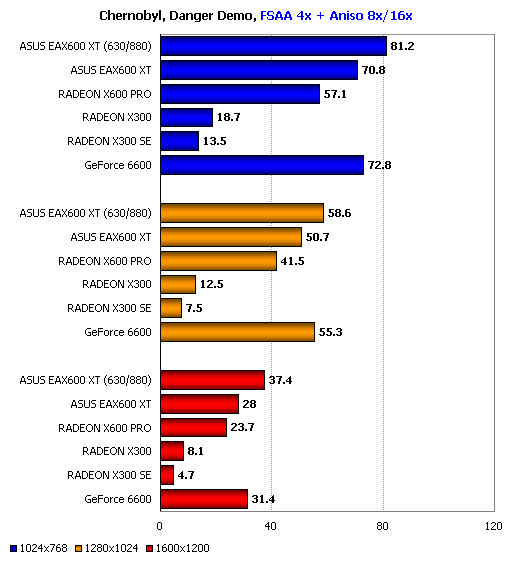
As the load on the memory subsystem grows when FSAA and AF are enabled, the GeForce 6600 loses much, since the slow memory with a frequency of 500 MHz is not able to “feed” the graphics processor in this mode. In this case, even the unclocked ASUS Extreme AX600 XT demonstrates a performance level comparable to the GeForce 6600, and even slightly outperforms it when overclocked.
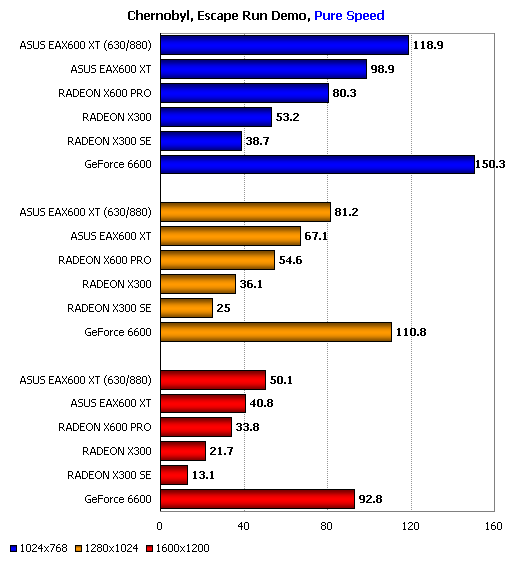
On the second level of this game, the geometry is even more complex than on the first. The situation looks the same – the GeForce 6600 is ahead by a huge margin, behind it is the overclocked card from ASUS, and the overclocked Extreme AX600 XT is only in third place.
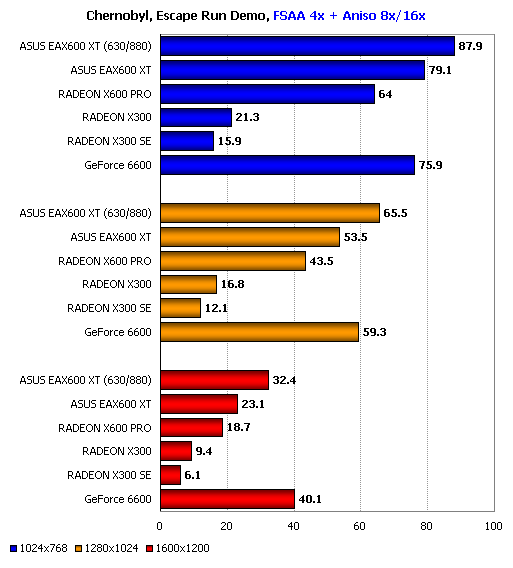
In the mode with FSAA and anisotropic filtering, the situation is somewhat different than at the Danger level – here, due to the increased geometry complexity, the GeForce 6600 already at 1280×1024 manages to outperform ASUS Extreme AX600 XT operating at nominal frequencies. In the highest resolution, the hero of today’s review does not even save overclocking. Outdated architecture and the presence of only two vertex processors do their dirty work.
Game tests: Splinter Cell: Pandora Tomorrow
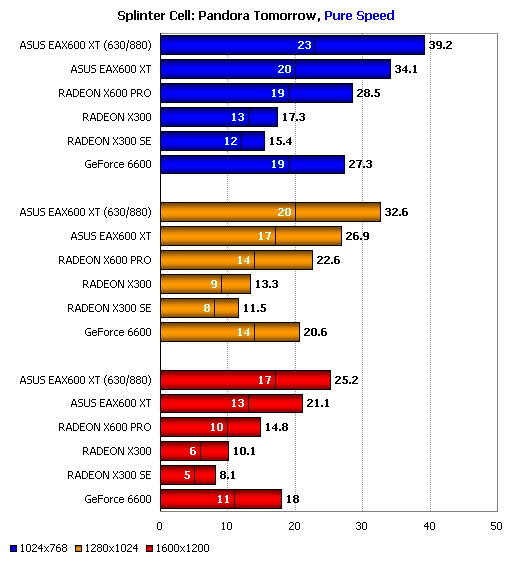
This third-person shooter is not rich in textures, as it is a port from the game console. There are a lot of pixel shaders here, and they are complex enough, however, not so difficult that they become a difficulty for the RADEON X600 architecture. Take a look at the diagram – ASUS Extreme AX600 XT outperforms GeForce 6600 in all resolutions. True, with the increase in resolution, this gap narrows, but, nevertheless, the leadership remains with the card from ASUS. Overclocking only further strengthens her position in this game.
Game tests: Prince of Persia: Sands of Time
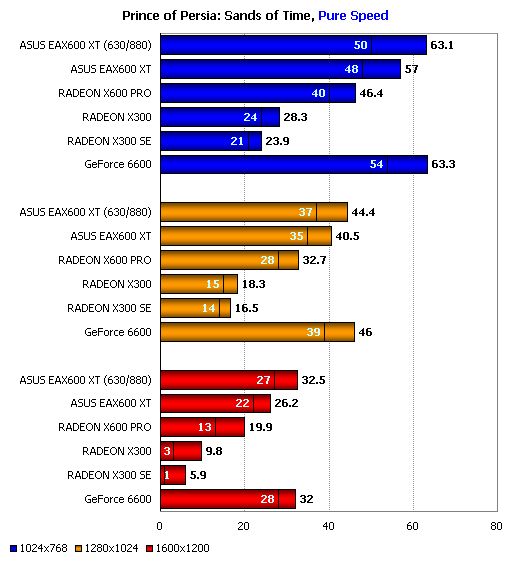
In another famous third-person shooter, Prince of Persia: Sands of Time, the GeForce 6600, on the other hand, feels more comfortable than in the previous game. However, its advantage here is not so great, and overclocking the Extreme AX600 XT allows you to achieve the same results. As a reminder, both Splinter Cell: Pandora Tomorrow and Prince of Persia: Sands of Time are tested in manual mode, therefore, the results obtained may not be entirely accurate.
Game tests: Max Payne 2: The Fall of Max Payne
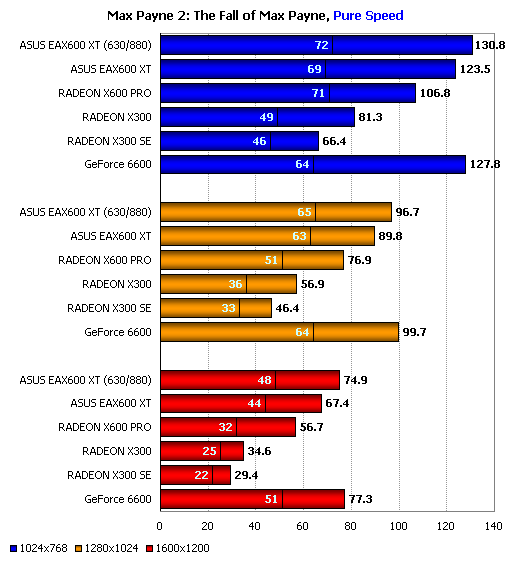
Max Payne 2 also does not shine with complex graphic effects. Here ASUS Extreme AX600 XT lags behind the GeForce 6600 a little, but only when working at the nominal frequencies. When overclocked, this video adapter demonstrates the same results as the new generation solution from NVIDIA.
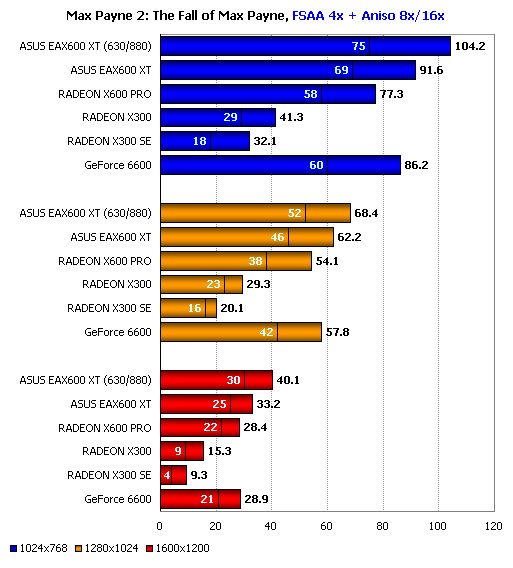
Eye Candy mode is a challenge for the GeForce 6600 with its extremely slow memory, therefore ASUS Extreme AX600 XT comes out ahead in it, although its superiority is insignificant in the nominal mode. The effect of overclocking is clearly visible, as in all previous cases – such a significant increase in the frequencies of the graphics core and memory could not but affect the performance.
Game tests: IL-2 Sturmovik: Aces in the Sky
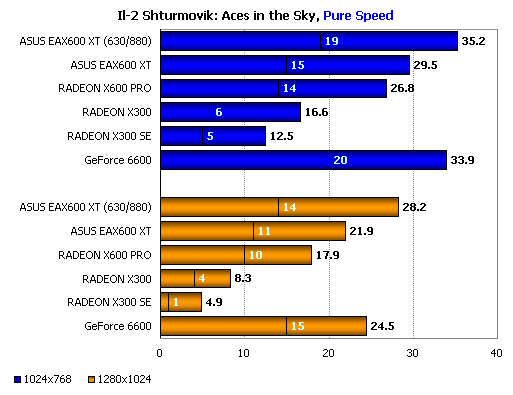
In Asah in the Sky, the new architecture and eight pixel pipelines work equally well as the high frequencies at which the overclocked ASUS Extreme AX600 XT works. The same video adapter, operating at nominal frequencies, demonstrates much more modest results.
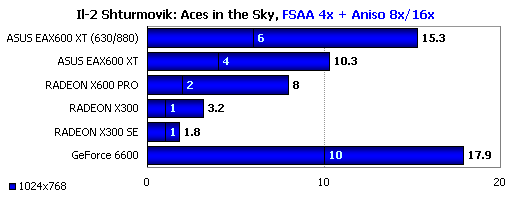
With FSAA and anisotropic filtering enabled, the GeForce 6600 retains its first place. It is followed by the overclocked ASUS Extreme AX600 XT with a margin of 2 FPS.
Game Tests: Lock On
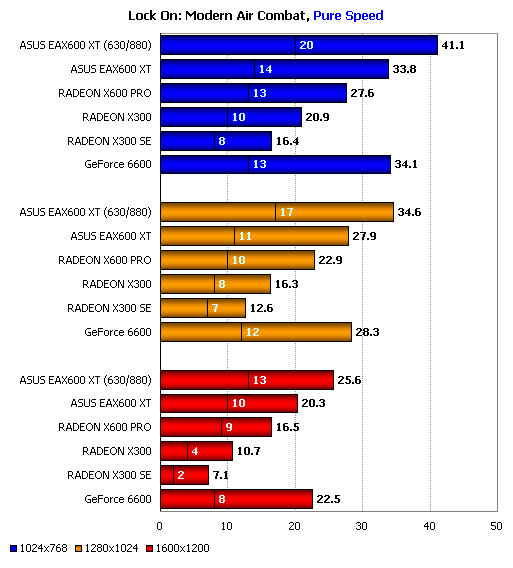
This flight simulator is quite complicated from a graphical point of view, but there are very few pixel shaders in it. The modern architecture, which the GeForce 6600 possesses, has practically nothing to do here, however, despite this, it shows the same performance level as the ASUS product. Overclocking Extreme AX600 XT has a very strong effect.
We remind our readers that the game can behave unpredictably and reset graphical settings, therefore, the results obtained in it should be treated with caution.
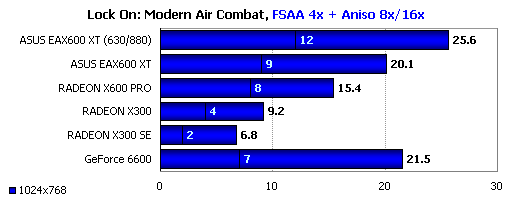
GeForce 6600 and ASUS Extreme AX600 XT show almost the same results. The effect of overclocking the latter is quite noticeable in this case – the performance gain is 25%!
Game Tests: Colin McRae Rally 04
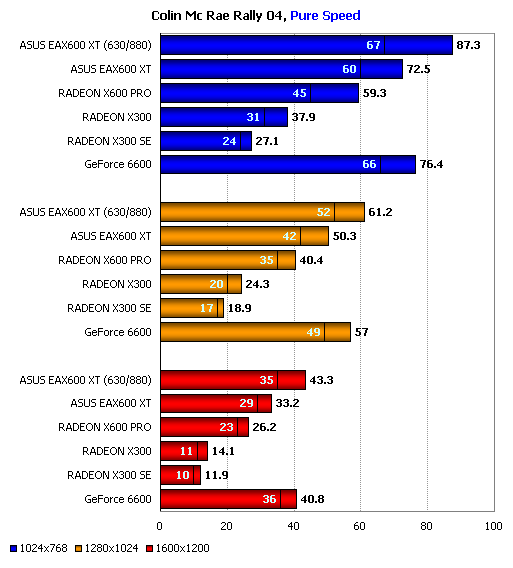
In Colin McRae Rally, the ASUS card initially performs worse than the GeForce 6600, especially at high resolutions, but a successful overclocking allows Extreme AX600 XT to catch up and even slightly outperform the most dangerous rival. This game was also tested in manual mode, therefore, the results obtained may not be entirely correct.
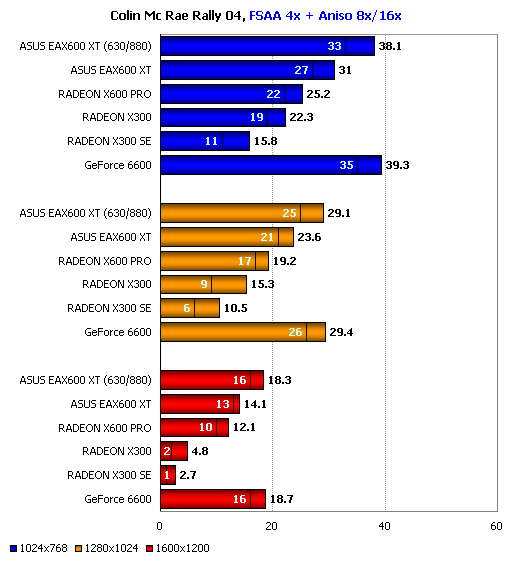
With anti-aliasing and anisotropic filtering enabled, the GeForce 6600 also outperforms the ASUS product operating at nominal frequencies. Overclocking again allows you to equalize the results.
Game tests: Command & Conquer Generals: Zero Hour
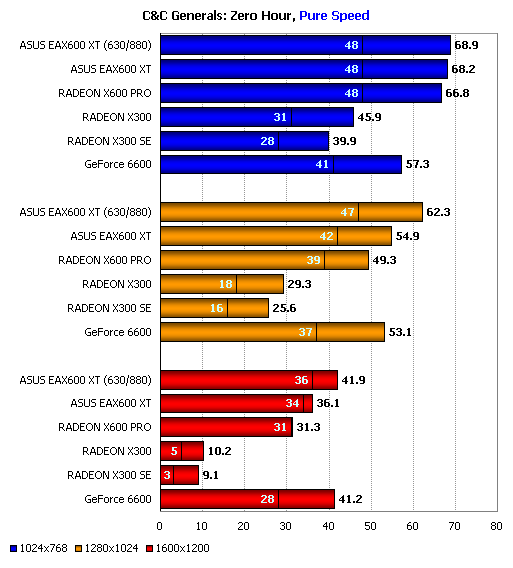
This game also loves the presence of fast memory on board the video adapter and high speed of work with pixel shaders. At 1024×768, ASUS Extreme AX600 XT reaches a performance ceiling that the GeForce 6600 cannot do due to low clock frequencies. However, already at 1280×1024 the latter shows the same result as the card from ASUS, and at the highest resolution only the overclocked Extreme AX600 XT can go on an equal footing with the GeForce 6600.
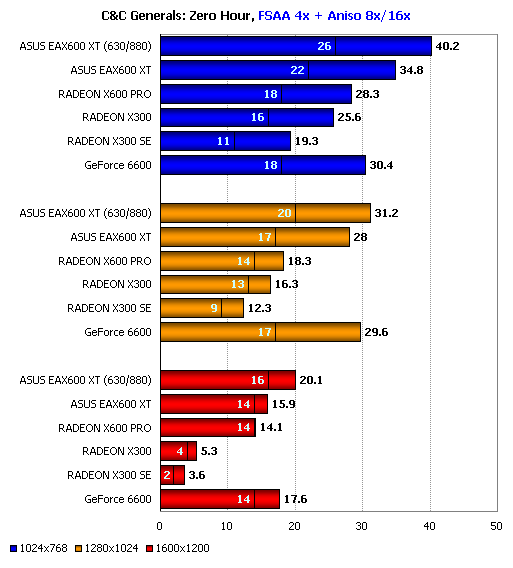
The fast memory helps the ASUS card not to lose its face in the Eye Candy mode, however, at high resolutions it is still slightly inferior to the GeForce 6600 when operating at nominal frequencies.
Game Tests: Perimeter
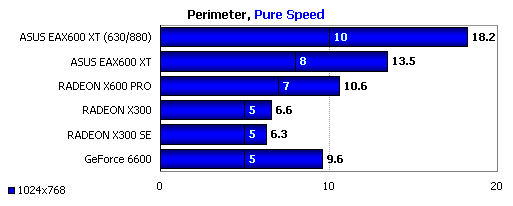
Playability is out of the question in Perimeter – only monsters belonging to the RADEON X800 or GeForce 6800 families provide it in this game. Nevertheless, ASUS EAX600 XT shows the best result among other cards that took part in the tests.
Semi-synthetic tests: Aquamark3
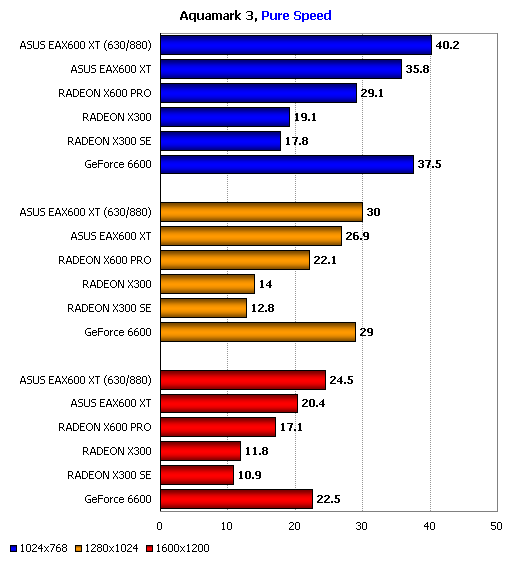
Aquamark3 has a few complex shaders; This test is more famous for its complex geometry and high overdraw ratio. In this case, ASUS Extreme AX600 XT only slightly lags behind the GeForce 6600 and catches up with it in overclocked mode.
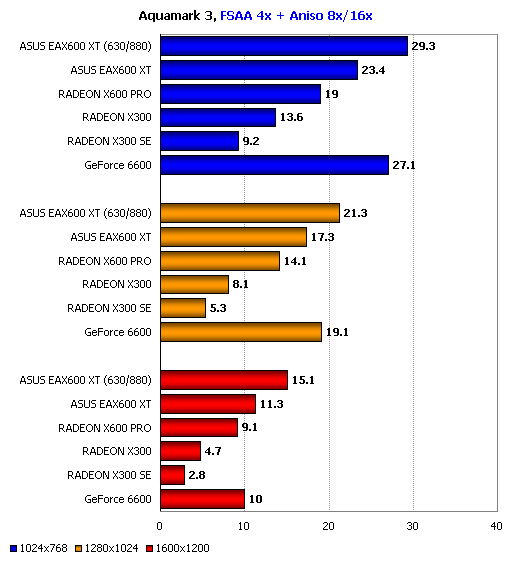
When FSAA and anisotropic filtering are enabled, everything is much more interesting – the GeForce 6600 shows good results at 1024×768, however, at 1600×1200 it is clearly hampered by extremely slow memory. ASUS Extreme AX600 XT is devoid of this drawback, therefore, it is in high resolutions that it feels better than its rival.
Synthetic tests: Futuremark 3DMark03
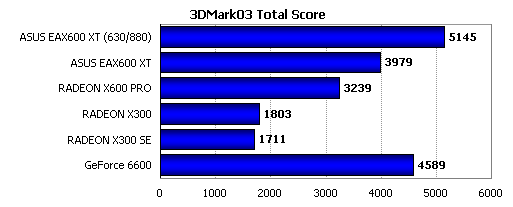
Initially, the best result in this test package is demonstrated by GeForce 6600, however, the ability of ASUS Extreme AX600 XT to work stably at significantly increased frequencies allowed it to take the first place in overclocking mode with an advantage of about 500 points. Let’s take a closer look at the situation in 3DMark03.
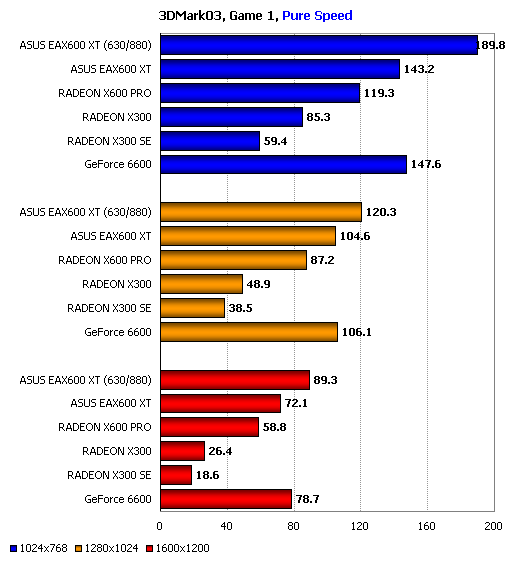
Do not forget that the first game test is not something particularly difficult for any more or less modern map. The Extreme AX600 XT manages to take the lead in it due to extremely successful overclocking, while at the nominal frequencies it lags slightly behind the GeForce 6600.
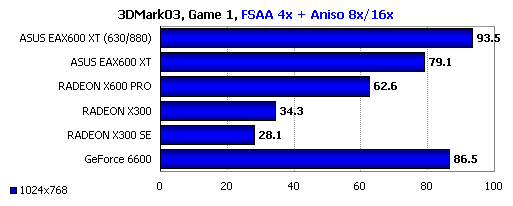
In Eye Candy mode, the superiority of the overclocked ASUS card becomes insignificant, just as its lag behind the GeForce 6600 is insignificant when operating at nominal frequencies.
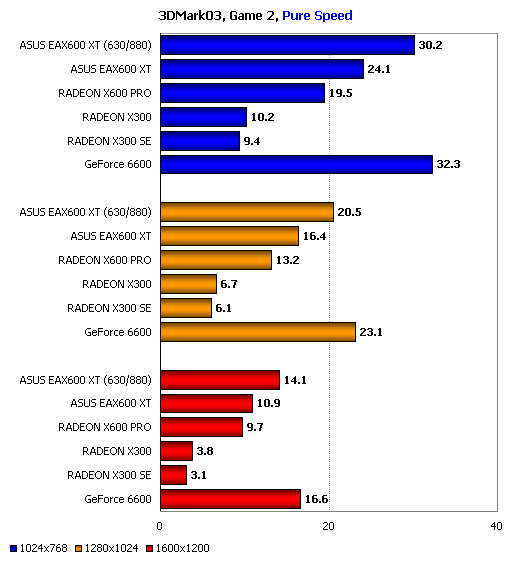
The second gaming test, as you know, uses rendering algorithms that work best on cards based on NVIDIA architectural solutions, therefore, the victory of the GeForce 6600 in this test is not surprising. However, the advantage of this video adapter over the overclocked ASUS Extreme AX600 XT is small – no more than 2-3 FPS.
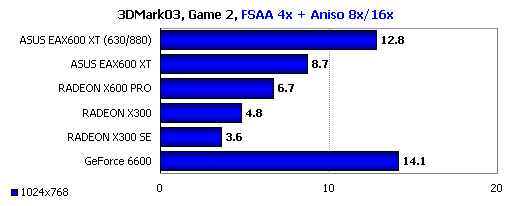
The same picture is observed in the Eye Candy mode, when full-screen anti-aliasing and anisotropic filtering are simultaneously involved.
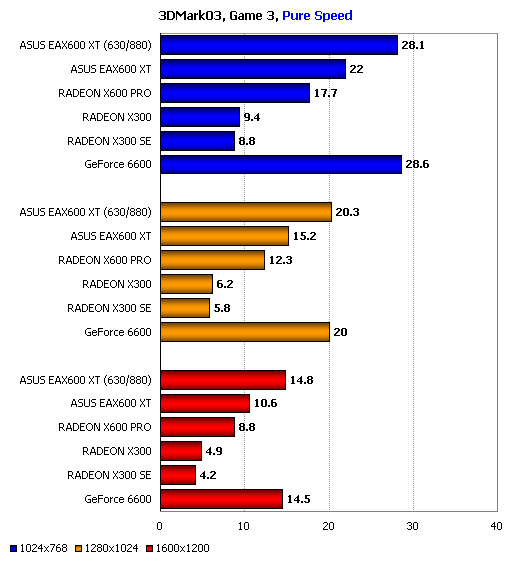
The third test is not much different from the second, so the picture in it is almost the same as in the previous case. The only difference is the complete similarity of the results of the overclocked card from ASUS and the GeForce 6600, while, as in the second test, the latter is still a little faster.
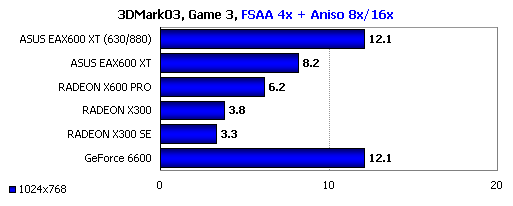
When FSAA and anisotropic filtering are enabled, there are no fundamental changes – as before, only overclocking allows Extreme AX600 XT to reach the level of GeForce 6600.
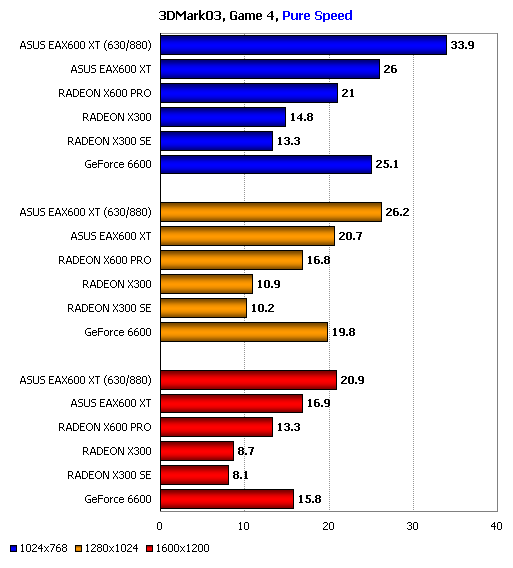
The fourth gaming test is perhaps the most important and most interesting test of the 3DMark03 package, as it is saturated with complex pixel shaders 2.0. In this case, parity is again observed between the high clock frequencies of ASUS Extreme AX600 XT and the advanced architecture of the GeForce 6600. Overclocking the ASUS product leads to a very noticeable increase in performance, making it the leader.
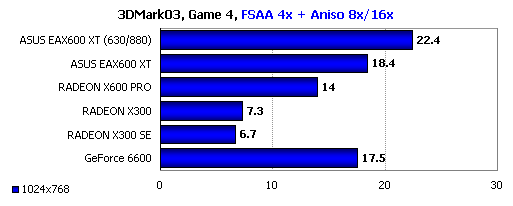
The situation is similar in the EyeCandy mode. On the whole, ASUS Extreme AX600 XT / HTVD did not perform as well in 3DMark03 as the GeForce 6600, but this is not surprising, since it is architecturally analogous to the RADEON 9600 XT; the only difference is in the memory frequency and the presence of the PCI Express interface. However, the excellent overclocking potential played into the hands of the described product. Thanks to him, the Extreme AX600 XT video adapter was able to demonstrate excellent results for its class in the test suite from FutureMark.
Conclusions and conclusion
The new product from ASUS in the face of the Extreme AX600 XT / HTVD video adapter left an ambiguous impression of itself. On the one hand, sufficiently high performance and excellent overclocking potential testify in favor of the described product, but, on the other hand, the card is based on an outdated architecture, which is unlikely to provide a comfortable level of performance in next generation games, and also lacks full support for multi-monitor display. However, the latter is understandable: the fact is that ASUS Extreme AX600 XT / HTVD is a special product intended for a certain category of buyers, namely for owners of plasma panels, video projectors and other video information display devices equipped with a YPbPr component video input. Unfortunately, we were unable to test the HDTV video processing capabilities, because,
As for the rest, the card is analogous to the RADEON X600 XT, so you shouldn’t expect any special results from it when operating at nominal frequencies:
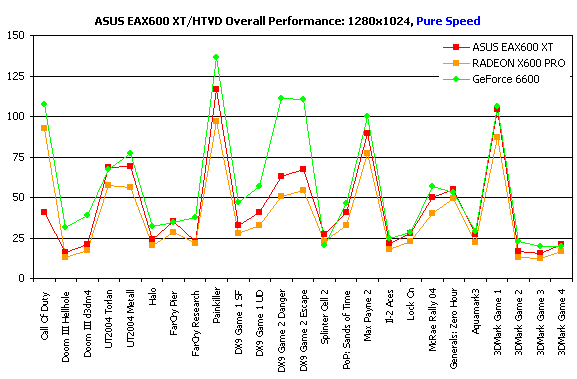
As you can see, the average lag behind the GeForce 6600 is large enough to consider the RADEON X600 architecture outdated. Only significant overclocking helps ASUS Extreme AX600 XT achieve a performance level comparable to that demonstrated by GeForce 6600. However, for some modern games, in particular, for Doom III, this is not enough.
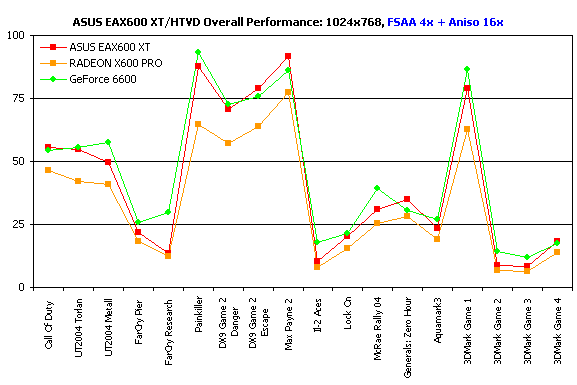
In Eye Candy mode, the situation looks less grim. Since, in this mode, the memory load greatly increases, the GeForce 6600 begins to suffer from a lack of bandwidth – after all, it has a slow memory operating at frequencies of about 500 MHz. With the same width of the memory access bus, the speed of its operation in ASUS Extreme AX600 XT is much higher, especially in overclocked mode. As a result, the overclocked card from ASUS in this case looks, on the whole, more attractive than the GeForce 6600.
At the moment, the cost of ASUS Extreme AX600 XT / HTVD, according to Pricewatch.com, is around $ 240, which is quite expensive. For the same or less price, you can buy much more productive GeForce 6600 GT or RADEON X700 PRO from other manufacturers, and adding another $ 30, you can count on getting a GeForce 6800. That is why we cannot recommend the described product to those who are going to buy a system with PCI Express interface for playing modern and future games, however, ASUS Extreme AX600 XT / HTVD is quite suitable for those who do not need ultra-high performance in 3D mode, but want to get at their disposal a card capable of working with HDTV devices and equipped with functions video capture.
ASUS Extreme AX600 XT / HTVD: pros and cons
Advantages:
High quality 2D;
Support for VIVO functions;
HDTV support;
Excellent overclocking potential;
Spectacular appearance;
Support for proprietary ASUS technologies;
Rich delivery set.
Flaws:
Lack of support for two monitors;
High price.





